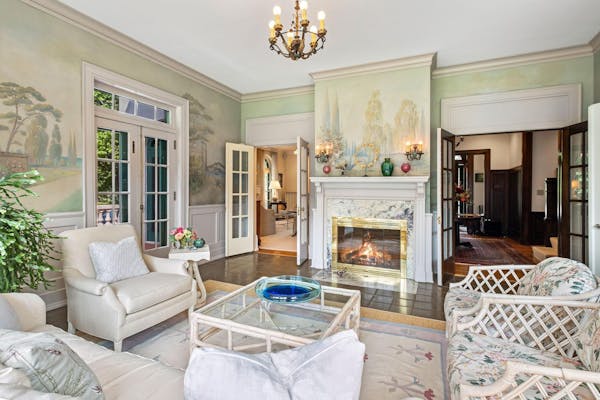Tiny home fans have an array of reasons for choosing the lifestyle. For starters, it's cost-effective and a way to combat climate change.
For Matt Broshat, he had an additional incentive to build a 120-square-foot bunkhouse in his St. Paul backyard: His roommate was loud.
"It was a mix of wanting my own little space back and also learning how to build and seeing where it went," said Broshat, who leases rooms to friends at his house in the Dayton's Bluff neighborhood. "I just watched a lot of YouTube videos and as time went on I built my skills. ... It's been a really fun journey."
The project, which he started in June 2022, took two months to complete and cost about $8,000. He's selling it for the same amount — if a buyer can solve the puzzle of how to move it, something that's been an obstacle for interested buyers.
Building blocks
When tackling his backyard build, he took everything he learned from remodeling his house, which was built in 1919, utilizing YouTube when he came across a new problem.
During the day, he worked at his family's company Wrap-It Storage and then hopped into his hatchback, headed to Menards, picked up supplies and spent hours working in his backyard.
The just-for-fun project came with a hefty price tag, in part because he had to buy new tools. To keep costs down, some of his materials — such as the flooring — were selected at the clearance section.
He decided not to include a kitchen or bathroom, since he had access to the main house. He outfitted his bunk house with a loveseat, television, desk and mini-refrigerator. There's a sleeping loft, with a staircase that doubles as a bookshelf. And Broshat also added some shelving on the loft level for clothing. The space is insulated and equipped with heat so that it can be used during the winter, too.
"For a few nights I lived here last winter. It was 10 degrees outside when I was sleeping in here," he said. "It took about 30 minutes to heat up to 65 degrees."
But he admits that living in his guesthouse full-time might be a little rough.
"I think Minnesota is a hard spot to live in here just because it gets so cold during the winter," he said.
Broshat has since moved from St. Paul and is living in south Minneapolis with family. He's selling the structure to make more space in the backyard for the people now renting the house.
He thinks the structure would make a great guesthouse for someone else's backyard. Or it could be converted into a home office or storage unit.
The only problem? In essence, it's stuck between a rock and a hard place. Or between a tree and a garage, in this case.
"It's almost like you need 30 people to lift it out of here," he said. "I could probably sell it for $15,000, but I have it listed for $8,000 just for the fact that if I could get it sold [and moved] that would be great."
Defining a tiny home
Broshat refers to the building as a bunkhouse or "tiny home." Most will agree it's tiny, but whether it technically can be considered a home depends on whom you ask.
A tiny home is loosely defined as a living structure under 400 square feet, according to Brad Wiseman, CEO and chairman of the Tiny Home Industry Association board of directors.
But definitions can vary by state or even by municipality. The Minnesota Department of Labor and Industry defines a tiny home as 400 square feet or less and having a toilet, sanitation, bath and shower spaces.
No matter what they're called, Wiseman said, the tiny home movement has continued to gain momentum. He estimates there are 70,000 to 150,000 such homes in the country.
In Minnesota, some cities have made it easier to build tiny homes. Just last year, the St. Paul City Council approved changes to its zoning code, removing restrictions about building size, location and occupancy, to combat a housing shortage.
Construction of tiny homes will likely gain steam in the near future, Wiseman said.
"Only the people who were willing to live in the gray areas used to be building tiny homes," he said. "But if you just let people live smaller, economies of scale come in" and that will bring down the price tag.
The next move
Broshat has enjoyed the project so much that when he finished building it, the 30-year-old quit his day job at his family's supply chain company, to start a full-time remodeling and construction business specializing in tiny homes.
"My dad was pretty bummed that I was leaving the family company, but I think they were excited for me, that I was building my skills and liking what I do," he said. "They were like 'Go for it, give it a shot.'"
Looking back on his first project, Broshat said there are things he would change. Now, he also knows how to install a bathroom if a customer wants one. While that may be optional, there's one thing that won't be next time.
"I would build a tiny house again, but I would find a paying customer and build it where they need it" rather than move it, he said.
At the time of publication, an offer was pending. To view Broshat's listing on Facebook Marketplace, visit bit.ly/broshat.

Pulitzer Prize winner Hernan Diaz, Oscar-anointed Percival Everett and bestseller Rebecca Makkai coming to Hopkins for Pen Pals
One way to appreciate teachers: These schools provide their day care


